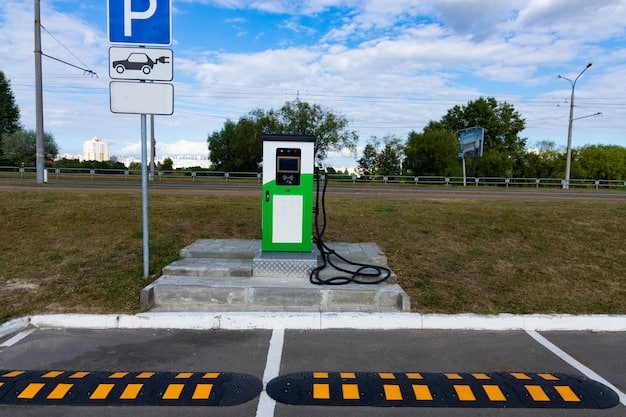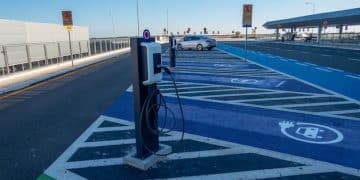How Will EV Adoption Reshape US Commuting by 2025?

The anticipated 15% surge in electric vehicle (EV) adoption by 2025 is poised to significantly alter US commuting patterns by promoting flexible work arrangements, optimizing transportation infrastructure, and reducing reliance on personal vehicles through shared mobility services.
As electric vehicles (EVs) gain traction across the United States, a projected 15% increase in their adoption by 2025 promises to reshape the daily lives of commuters. The question of how will the projected 15% increase in electric vehicle adoption by 2025 reshape US commuting patterns? is at the forefront of discussions among urban planners, policymakers, and everyday drivers alike.
The Rise of Electric Vehicles: A Commuting Revolution?
The growing popularity of electric vehicles is more than just a trend; it represents a significant shift in how Americans approach their daily commutes. As EVs become more affordable and accessible, they are poised to disrupt traditional commuting patterns and offer new possibilities for urban mobility.
Economic Factors Driving EV Adoption
The economic benefits of EVs are a major driver of their increasing adoption. Lower fuel costs and reduced maintenance needs make EVs an attractive option for budget-conscious commuters.
Environmental Concerns and Sustainability
Beyond the economic advantages, environmental concerns are also playing a crucial role. Many commuters are drawn to EVs because of their lower emissions and contribution to a more sustainable future.
- Government incentives, such as tax credits and rebates, are making EVs more affordable.
- Advancements in battery technology are increasing the range and performance of EVs.
- The expansion of charging infrastructure is making it easier for EV owners to keep their vehicles powered.
In conclusion, the growth of the EV market is driven by a combination of economic and environmental factors, setting the stage for a significant transformation in US commuting patterns.
Infrastructure Development to Support EV Growth
For the projected increase in EV adoption to truly reshape commuting patterns, robust infrastructure is essential. This includes not only the availability of charging stations but also smart grid technologies and urban planning that supports sustainable transportation.

Public Charging Infrastructure
The availability of public charging stations is a critical factor in encouraging EV adoption. Accessible and reliable charging infrastructure can alleviate range anxiety and make EVs a more practical choice for commuters.
Private and Workplace Charging Solutions
In addition to public charging, private and workplace charging solutions are also important. Many EV owners charge their vehicles at home or at work, providing convenience and reducing the need for public charging.
- Investing in smart grid technologies can optimize the distribution of electricity and support the growing demand for EV charging.
- Urban planning that prioritizes EV infrastructure can create more sustainable and livable cities.
- Collaboration between government, industry, and communities is essential for developing a comprehensive EV infrastructure plan.
In summary, the development of robust EV infrastructure is crucial for supporting the growing adoption of electric vehicles and transforming US commuting patterns.
The Impact on Urban and Suburban Commuting
The increasing adoption of EVs is expected to have a significant impact on both urban and suburban commuting. As more people switch to EVs, cities may see a reduction in traffic congestion and air pollution, while suburbs could become more connected and sustainable.
Reduced Congestion and Emissions in Urban Areas
One of the most significant benefits of EV adoption in urban areas is the potential for reduced congestion and emissions. EVs produce zero tailpipe emissions, helping to improve air quality and reduce the negative health impacts of traffic pollution.
Increased Connectivity and Sustainability in Suburbs
In suburban areas, EVs can increase connectivity and promote sustainability. With longer ranges and access to charging infrastructure, EVs can make it easier for suburban residents to commute to work or access amenities in urban centers.

The shift to EVs in urban and suburban areas can lead to more sustainable and livable communities. With reduced emissions and improved air quality, cities and suburbs can become more attractive places to live and work.
In conclusion, the increasing adoption of EVs is poised to transform urban and suburban commuting patterns, leading to more sustainable, connected, and livable communities.
Changing Work Patterns and Commuting Needs
The rise of remote work and flexible work arrangements is also influencing commuting patterns and the demand for EVs. As more people work from home, the need for daily commutes may decrease, but EVs can still play a role in occasional trips and errands.
The Rise of Remote Work
The COVID-19 pandemic accelerated the trend toward remote work, and many companies are now offering employees the option to work from home permanently or on a hybrid basis. This shift has reduced the need for daily commutes and changed the way people think about transportation.
Flexible Work Arrangements
Even for those who still commute to work, flexible work arrangements are becoming more common. Flexible hours, compressed workweeks, and other alternative schedules can help to reduce traffic congestion and make commuting more manageable.
The combination of remote work, flexible work arrangements, and EV adoption is creating a new paradigm for commuting. As people have more choices about where and when they work, they can also make more sustainable transportation choices.
In summary, changing work patterns are influencing commuting needs and driving the demand for EVs as a sustainable transportation option.
Government Policies and Incentives
Government policies and incentives play a crucial role in promoting EV adoption and shaping commuting patterns. Tax credits, rebates, and other incentives can make EVs more affordable, while regulations and infrastructure investments can support the growth of the EV market.
Financial Incentives for EV Purchases
Many governments offer financial incentives, such as tax credits and rebates, to encourage people to purchase EVs. These incentives can significantly reduce the upfront cost of an EV, making it more accessible to a wider range of consumers.
Infrastructure Investments and Regulations
In addition to financial incentives, governments can also support EV adoption through infrastructure investments and regulations. Investing in charging infrastructure, setting emissions standards, and providing preferential treatment for EVs can all help to accelerate the transition to electric transportation.
Government policies and incentives are essential for creating a supportive environment for EV adoption. By making EVs more affordable, accessible, and convenient, governments can help to shape commuting patterns and promote sustainable transportation.
- Federal and state tax credits for EV purchases
- Rebates and grants for charging infrastructure development
- Emissions standards and regulations for vehicles
In closing, government policies are important for driving the adoption of EVs.
The Future of Commuting: Integrated Mobility Solutions
Looking ahead, the future of commuting is likely to involve a combination of EVs, public transportation, shared mobility services, and micromobility options. Integrated mobility solutions can provide commuters with a seamless and sustainable transportation experience.
The Role of Public Transportation
Public transportation will continue to play a crucial role in urban commuting, and EVs can complement public transit by providing a clean and efficient way to get to and from transit stations.
Shared Mobility Services and Micromobility
Shared mobility services, such as ride-hailing and car-sharing, can also help to reduce reliance on personal vehicles and make commuting more convenient. Micromobility options, such as electric scooters and bikes, can provide a sustainable way to travel short distances.
Integrated mobility solutions can make commuting more sustainable, efficient, and convenient. By combining EVs with other transportation options, cities can create a more seamless and user-friendly transportation experience for commuters.
In conclusion, the future of commuting will involve a combination of EVs, public transportation, shared mobility services, and micromobility options.
| Key Point | Brief Description |
|---|---|
| 🚗 EV Adoption | Projected 15% increase by 2025 will reshape US commuting. |
| ⚡ Infrastructure | Charging stations are pivotal for EV growth. |
| 🏢 Work Patterns | Remote work influences commuting needs. |
| 🌱 Sustainability | EVs help urban and suburban areas become greener. |
Frequently Asked Questions
▼
With more electric vehicles on the road, urban centers benefit from less congestion due to optimized traffic flow, and reduced emissions lead to improved local air quality.
▼
While charging infrastructure is growing rapidly, expanding public and private charging stations along highways and in workplaces remains crucial to support broader EV use.
▼
Yes, advancements in battery technology have significantly expanded the driving range of EVs. Many models can now comfortably handle longer commutes without needing frequent recharges.
▼
Switching to an EV offers numerous savings, including lower fuel costs, reduced maintenance expenses, and eligibility for tax incentives and rebates from federal and potentially state programs.
▼
Governments support EV adoption through financial incentives like tax credits and rebates, investments in public charging infrastructure, and regulations promoting sustainable transportation practices.
Conclusion
In conclusion, the projected increase in **electric vehicle** adoption by 2025 is set to reshape US commuting patterns in profound ways. From reducing congestion and emissions in urban areas to increasing connectivity and sustainability in suburbs, EVs offer a pathway to a more sustainable, efficient, and convenient transportation future. As infrastructure continues to develop and government policies support EV adoption, the shift to electric vehicles promises to transform the way Americans commute and contribute to a cleaner, healthier environment.





